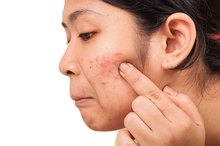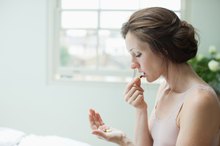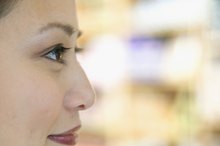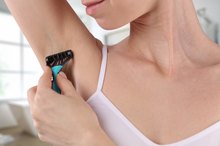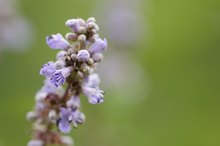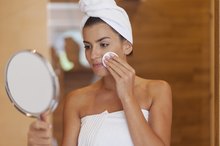Adult Acne & Facial Hair Related to a Hormonal Imbalance
For many teenagers, acne is a rite of passage, marking the transition from puberty to adolescence, and finally clearing up in adulthood. Most adults never imagine having to deal with it in later life, but for some--mainly women--acne remains.
Although acne flareups can occur due to clogged pores, menses, menopause, or a hormonal imbalance, Polycystic Ovarian Syndrome (PCOS) is strongly indicated when acne is coupled with facial hair 1. As the name suggest, Polycystic Ovaries refers to a number of beaded cysts growing in and outside the ovaries.
Polycystic Ovaries
Normally functioning ovaries produce the hormones estrogen, progesterone and androgen. These regulate ovulation and the menstrual cycle. **When a developed egg is released each month, a woman has a period.
When elevated levels of androgens are released, the ovulation and menstrual cycle process is disrupted 4. Fully developed eggs are not released but instead mutate into fluid-filled sacs. After some time, cysts develop and build up inside and on the ovaries. Although both men and women have androgens, it is generally referred to as being the "male hormone" because the male body naturally produces and uses more of it 4. When a woman has an excess of this hormone, she may develop facial hair and acne, among other symptoms characteristic of PCOS. **
- Normally functioning ovaries produce the hormones estrogen, progesterone and androgen.
- When a woman has an excess of this hormone, she may develop facial hair and acne, among other symptoms characteristic of PCOS.
Signs and Symptoms
Home Remedy for an Infected Pimple
Learn More
Other signs of PCOS are male-pattern balding and acne, particularly around the jawline. Missed or irregular periods are another strong indication, as is obesity and weight gain, specifically around the midsection and waistline.
Hair growth is not limited to the face, and a sufferer may experience superfluous amounts on the stomach, chest, arms and legs.
Infertility is also a symptom, and one may face difficulty in conceiving or experience multiple miscarriages. Diabetes, heart disease, high blood pressure and cancer are also complications of PCOS.
- Other signs of PCOS are male-pattern balding and acne, particularly around the jawline.
- Hair growth is not limited to the face, and a sufferer may experience superfluous amounts on the stomach, chest, arms and legs.
Causes
PCOS is both a genetic and environmental disorder. Although some may be predisposed, lifestyle and dietary factors can bring on, improve or worsen the condition. It’s not clear whether PCOS is brought on by weight gain, or if weight gain is a symptom of the disease. Research indicates this condition may develop as a result of elevated insulin or insulin resistance. When the body is resistant to insulin or is unable to utilize it, blood-sugar levels rise and glucose is transformed into fat, which explains the weight gain and obesity. Also, elevated androgens may result from insulin resistance or be a trigger for it 4.
- PCOS is both a genetic and environmental disorder.
- It’s not clear whether PCOS is brought on by weight gain, or if weight gain is a symptom of the disease.
Adult Acne Treatment
What Causes Blackheads on My Back?
Learn More
Sufferers of adult acne have to deal with issues involving both physical and mental health. Unsightly scars and pimples can be a great source of embarrassment, leaving the sufferer vulnerable to anxiety or even depression. Topical treatments that target a younger market can pose some problems for adults, as older skin is thinner and prone to dryness. Oral medications like the contraceptive pill and hormone-replacement therapy can effectively eradicate acne, but these are usually prescribed to counteract menopausal or hormonal symptoms or for birth control.
Oral antibiotics can be used to treat severe cases of acne, and sufferers may benefit from oral isotretinoin. Be sure to consult a dermatologist for advice in determining a treatment plan suitable for you.
- Sufferers of adult acne have to deal with issues involving both physical and mental health.
- Topical treatments that target a younger market can pose some problems for adults, as older skin is thinner and prone to dryness.
Hair Removal
Shaving is the fastest way to remove hair from the body, but it’s not effective when dealing with facial hair, as it can lead to razor bumps and stubble.
Bleach kits and depilatory creams are safe and effective in removing facial hair, but make sure the skin is not broken or sensitive. Follow the instructions closely to avoid irritation.
Tweezers work well with stray chin hairs, but not for large areas.
Waxing is very effective, albeit quite painful. If you chose this option, you will be hair-free for longer periods, and the hair grows back finer each time you wax.
- Shaving is the fastest way to remove hair from the body, but it’s not effective when dealing with facial hair, as it can lead to razor bumps and stubble.
- Bleach kits and depilatory creams are safe and effective in removing facial hair, but make sure the skin is not broken or sensitive.
Electrolysis & Laser
Electrolysis is another alternative offering permanent hair removal. It works by attacking the hair follicle to inhibit hair growth. **This technique can be time-consuming and expensive, and the results are not always permanent.
** Laser treatments are the most expensive of all hair removal procedures, and for some, it effectively removes hair permanently. Darker-skinned people should seek advice from a consultant to verify laser and electrolysis treatments are suitable, as injury to the epidermis may occur.
- Electrolysis is another alternative offering permanent hair removal.
- Laser treatments are the most expensive of all hair removal procedures, and for some, it effectively removes hair permanently.
Related Articles
References
- Street Directory: Women's Jaw Acne
- Insulite Laboratories: Insulin Resistance, a Root Cause of PCOS
- E. Hormones: Androgens
- The Hair Removal Journal: What if I'm Tan or a Person of Color?
- New M, Yau M, Lekarev O, et al. Congenital Adrenal Hyperplasia. [Updated 2017 Mar 15]. In: Feingold KR, Anawalt B, Boyce A, et al., editors. Endotext [Internet]. South Dartmouth (MA): MDText.com, Inc.; 2000-. Available from: https://www.ncbi.nlm.nih.gov/books/NBK278953/
- Kairys N, Schwell A. Cushing Disease. [Updated 2019 May 5]. In: StatPearls [Internet]. Treasure Island (FL): StatPearls Publishing; 2019 Jan-. Available from: https://www.ncbi.nlm.nih.gov/books/NBK448184/
- Allen MJ, Sharma S. Physiology, Adrenocorticotropic Hormone (ACTH) [Updated 2019 Mar 3]. In: StatPearls [Internet]. Treasure Island (FL): StatPearls Publishing; 2019 Jan-. Available from: https://www.ncbi.nlm.nih.gov/books/NBK500031/
- Alpañés, Macarena; Fernández-Durán, Elena; Escobar-Morreale, Héctor F. Androgens and Polycystic Ovary Syndrome. https://www.medscape.org/viewarticle/754292
- Simon, James. Androgen. HealthyWomen.org. http://www.healthywomen.org/condition/androgen
- Bani Mohammad M, Majdi Seghinsara A. Polycystic Ovary Syndrome (PCOS), Diagnostic Criteria, and AMH. Asian Pac J Cancer Prev. 2017;18(1):17–21. Published 2017 Jan 1. doi:10.22034/APJCP.2017.18.1.17
- Antoniou-Tsigkos A, Zapanti E, Ghizzoni L, et al. Adrenal androgens. Endotext. Updated January 5, 2019.
- Horstman AM, Dillon EL, Urban RJ, Sheffield-Moore M. The role of androgens and estrogens on healthy aging and longevity. J Gerontol A Biol Sci Med Sci. 2012;67(11):1140–1152. doi:10.1093/gerona/gls068
- Pasquali R, Zanotti L, Fanelli F, et al. Defining Hyperandrogenism in Women With Polycystic Ovary Syndrome: A Challenging Perspective. J Clin Endocrinol Metab. 2016;101(5):2013-22.
- Rosenfield RL, Ehrmann DA. The Pathogenesis of Polycystic Ovary Syndrome (PCOS): The Hypothesis of PCOS as Functional Ovarian Hyperandrogenism Revisited. Endocr Rev. 2016;37(5):467–520. doi:10.1210/er.2015-1104
- Rosenfield RL. The Polycystic Ovary Morphology-Polycystic Ovary Syndrome Spectrum. J Pediatr Adolesc Gynecol. 2015;28(6):412–419. doi:10.1016/j.jpag.2014.07.016
- Yildiz BO, Bolour S, Woods K, Moore A, Azziz R. Visually scoring hirsutism. Hum Reprod Update. 2010;16(1):51–64. doi:10.1093/humupd/dmp024
- Held BL, Nader S, Rodriguez-rigau LJ, Smith KD, Steinberger E. Acne and hyperandrogenism. J Am Acad Dermatol. 1984;10(2 Pt 1):223-6.
- Shum KW, Cullen DR, Messenger AG. Hair loss in women with hyperandrogenism: four cases responding to finasteride. J Am Acad Dermatol. 2002;47(5):733-9.
- Yildiz BO. Diagnosis of hyperandrogenism: clinical criteria. Best Pract Res Clin Endocrinol Metab. 2006;20(2):167-76.
- Stanczyk FZ. Diagnosis of hyperandrogenism: biochemical criteria. Best Pract Res Clin Endocrinol Metab. 2006;20(2):177-91.
- Azziz R, Carmina E, Dewailly D, et al. The Androgen Excess and PCOS Society criteria for the polycystic ovary syndrome: the complete task force report. Fertil Steril. 2009;91(2):456-88.
- Wang R, Mol BW. The Rotterdam criteria for polycystic ovary syndrome: evidence-based criteria?. Hum Reprod. 2017;32(2):261-264.
- McCartney CR, Marshall JC. CLINICAL PRACTICE. Polycystic Ovary Syndrome. N Engl J Med. 2016;375(1):54–64. doi:10.1056/NEJMcp1514916
- Sheehan MT. Polycystic ovarian syndrome: diagnosis and management. Clin Med Res. 2004;2(1):13–27. doi:10.3121/cmr.2.1.13
- New M, Yau M, Lekarev O, et al. Congenital Adrenal Hyperplasia. [Updated 2017 Mar 15]. In: Feingold KR, Anawalt B, Boyce A, et al., editors. Endotext [Internet]. South Dartmouth (MA): MDText.com, Inc.; 2000-.
- Kairys N, Schwell A. Cushing Disease. [Updated 2019 May 5]. In: StatPearls [Internet]. Treasure Island (FL): StatPearls Publishing; 2019 Jan-.
- Allen MJ, Sharma S. Physiology, Adrenocorticotropic Hormone (ACTH) [Updated 2019 Mar 3]. In: StatPearls [Internet]. Treasure Island (FL): StatPearls Publishing; 2019 Jan-.
- Blouin K, Boivin A, Tchernof A. Androgens and body fat distribution. J Steroid Biochem Mol Biol. 2008;108(3-5):272-80.
- Sam S. Obesity and Polycystic Ovary Syndrome. Obes Manag. 2007;3(2):69–73. doi:10.1089/obe.2007.0019
- Diamanti-Kandarakis E, Dunaif A. Insulin resistance and the polycystic ovary syndrome revisited: an update on mechanisms and implications. Endocr Rev. 2012;33(6):981–1030. doi:10.1210/er.2011-1034
- Corbould A. Effects of androgens on insulin action in women: is androgen excess a component of female metabolic syndrome?. Diabetes Metab Res Rev. 2008;24(7):520-32.
- Dokras A. Cardiovascular disease risk factors in polycystic ovary syndrome. Semin Reprod Med. 2008;26(1):39-44.
- Mueck AO. Treatment of hyperandrogenism in women with ethinylestradiol and cyproteroneacetate. Eur J Contracept Reprod Health Care. 2017;22(3):170-171.
- de Melo AS, Dos Reis RM, Ferriani RA, Vieira CS. Hormonal contraception in women with polycystic ovary syndrome: choices, challenges, and noncontraceptive benefits. Open Access J Contracept. 2017;8:13–23. Published 2017 Feb 2. doi:10.2147/OAJC.S85543
- Reismann P, Likó I, Igaz P, Patócs A, Rácz K. Pharmacological options for treatment of hyperandrogenic disorders. Mini Rev Med Chem. 2009;9(9):1113-26.
- Karakurt F, Sahin I, Güler S, et al. Comparison of the clinical efficacy of flutamide and spironolactone plus ethinyloestradiol/cyproterone acetate in the treatment of hirsutism: a randomised controlled study. Adv Ther. 2008;25(4):321-8.
- Kolodziejczyk B, Duleba AJ, Spaczynski RZ, Pawelczyk L. Metformin therapy decreases hyperandrogenism and hyperinsulinemia in women with polycystic ovary syndrome. Fertil Steril. 2000;73(6):1149-54.
- Sachdeva S. Hirsutism: evaluation and treatment. Indian J Dermatol. 2010;55(1):3–7. doi:10.4103/0019-5154.60342
- Chuan SS, Chang RJ. Polycystic ovary syndrome and acne. Skin Therapy Lett. 2010;15(10):1-4.
- Brady C, Mousa SS, Mousa SA. Polycystic ovary syndrome and its impact on women's quality of life: More than just an endocrine disorder. Drug Healthc Patient Saf. 2009;1:9–15. doi:10.2147/dhps.s4388
- Badawy A1, Elnashar A. “Treatment options for polycystic ovary syndrome.” Int J Womens Health. 2011 Feb 8;3:25-35. doi: 10.2147/IJWH.S11304.
- Alpañés, Macarena; Fernández-Durán, Elena; Escobar-Morreale, Héctor F. Androgens and Polycystic Ovary Syndrome.
- Armeni E1, Lambrinoudaki I2. “Androgens and cardiovascular disease in women and men.” Maturitas. 2017 Oct;104:54-72. doi: 10.1016/j.maturitas.2017.07.010. Epub 2017 Jul 29.
- Karrer-Voegeli S1, Rey F, Reymond MJ, Meuwly JY, Gaillard RC, Gomez F. “Androgen dependence of hirsutism, acne, and alopecia in women: retrospective analysis of 228 patients investigated for hyperandrogenism.” Medicine (Baltimore). 2009 Jan;88(1):32-45. doi: 10.1097/md.0b013e3181946a2c.
- Simon, James. Androgen. HealthyWomen.org.
Resources
Writer Bio
Eshe Asale is a holistic massage therapist who began writing in 1995 with articles appearing on various websites and in "Iqra" newspaper and the "Between Love, Hope and Fear" anthology. She holds a massage therapy certificate from Lourdes Institute, a Master of Arts in media studies/communications from Goldsmiths University and a Bachelor of Arts in writing and publishing/film studies from Middlesex University.



